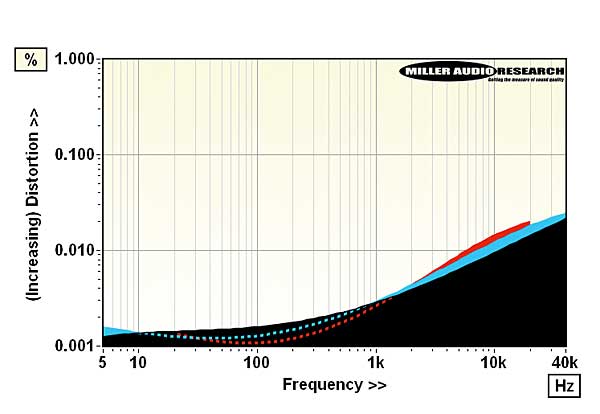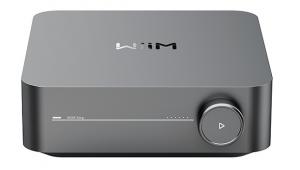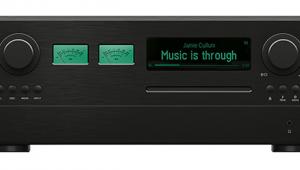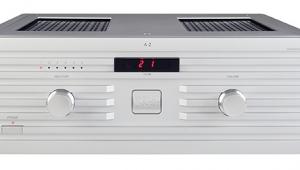Rotel DT-6000/RA-6000 CD Player/Amplifier Lab Report
ROTEL DT-6000
While Rotel has no Michi disc player to draw from, it might be tempting to suggest the DT-6000's DAC/analogue stage is otherwise inspired by the 'digital' section of the Michi P5 preamp [HFN May '20]. But it's not... In practice, the AKM AK4490EQ DAC used in the P5 is exchanged for an ESS ES9028PRO in the '6000 although Rotel is still using a minimum phase/steep roll-off digital filter option – the impulse test showing no pre-ringing but extended post-ringing. It also shows that the DT-6000's 4.2V balanced (2.1V unbalanced) maximum output is phase inverting and so, as there's no absolute phase option on either the player or remote [see p57], owners might wish to correct for this further down the signal chain. Also, the DT-6000's ~1.8kohm source impedance is arguably a little high for all cables/loads.
Otherwise, there are various areas where the DT-6000's 16-bit CD performance outstrips that of the 24-bit USB or S/PDIF inputs (it is also significantly better than that achieved by the digital preamp section of the RA-6000 – see p57). Sure enough, distortion is slightly lower with 24-bit data at 0.00013-0.001% versus 0.00016-0.0011% with CD (0dBFs, 20Hz-20kHz), but this is marginal [Graph 1, below], just as low-level linearity is the same at ±0.1dB and ±0.3dB over 100dBFs and 110dBFs ranges, respectively. The A-wtd S/N ratio is actually ~2dB wider via CD at 111.9dB vs. 110.0dB just as the jitter spectrum [Graph 2] is significantly 'tidier' with CD [black] than USB [red]. The absolute value of 119psec is limited by CD's 16-bit data format, but this still beats the USB input's 250psec. The responses are linked to sample rate, extending out to –0.4dB/20kHz, –1.7dB/45kHz and –4.5dB/90kHz with CD/48kHz, 96kHz and 192kHz media. PM


| Maximum output level / Impedance | 4.2Vrms / 1.7-1.9kohm (XLR) |
| A-wtd S/N ratio (USB / CD) | 110.0dB / 111.9dB |
| Distortion (1kHz, 0dBFs/–30dBFs) | 0.00013% / 0.0050% |
| Distortion & Noise (20kHz, 0dBFs/–30dBFs) | 0.0010% / 0.0052% |
| Freq. resp. (20Hz-20kHz/45kHz/90kHz) | +0.0 to –0.4dB/–1.7dB/–4.5dB |
| Digital jitter @ 48kHz (USB / CD) | 250psec / 119psec |
| Resolution @ –100dB (USB / CD) | ±0.1dB / ±0.1dB |
| Power consumption | 8W (1W standby) |
| Dimensions (WHD) / Weight | 431x104x320mm / 8.1kg |
| Prices | £1999 |
ROTEL RA-6000
Rotel claims its RA-6000 leverages off Michi X5 [HFN Jul '21] and X3 [HFN Apr '21] amp technology and, indeed, its performance lies midway between the latter and the RA-1582MKII [HFN Jan '22]. Differences are slight – the RA-6000 tuned to offer a lower +22.2dB overall gain rather than the X3/RA-1592mkII's +24.0dB, and with a proportionally lower 77.8dB A-wtd S/N ratio (vs. 80dB/81dB). However, the underlying principle of offering a gain closer to that of a typical power amp than an integrated (+40dB to +45dB) allows better use of the volume control with today's (balanced) line-level sources. Like the Michi X3 and RA-1592MKII, the RA-6000 is rated at 200W/8ohm and succeeds in delivering 2x225W and 2x425W at <1% THD with sufficient headroom to support an identical 308W, 585W, 1.07kW and 1.75kW (41.8A) into 8, 4, 2 and 1ohm loads under dynamic conditions [see Graph 1]. The response mirrors that of the RA-1592MKII (–0.1dB/20kHz to –0.5dB/100kHz) while the output impedance is fractionally lower at 0.016-0.022ohm (vs. 0.029-0.042ohm, re. 20Hz-20kHz). Distortion is unchanged at 0.0012-0.018% (10W/20Hz-20kHz), the trend, again, broadly consistent across a 1W-200W/8ohm output [see Graph 2].
The RA-6000 and '1592MKII share a similar 'digital' section, their TI PCM5242 DAC and short linear phase filter offering a limited 44dB stopband rejection but responses that are flat out to –0.03dB/20kHz, –0.6dB/45kHz and –1.3dB/90kHz with 48kHz, 96kHz and 192kHz media. Again, jitter is a little poorer at 705psec (48kHz) versus 175psec (96kHz) and the A-wtd S/N is about 3dB adrift at 99.5dB. Finally, THD via this 'digital' stage is lower than achieved in the '1592MKII at 0.002-0.014% (0dBFs, 20Hz-20kHz) but is second to the DT-6000. PM


| Continuous power (<1% THD, 8/4ohm) | 255W / 425W |
| Dynamic power (<1% THD, 8/4/2/1ohm) | 308W / 585W / 1065W / 1750W |
| Output impedance (20Hz–20kHz) | 0.016-0.022ohm (96ohm, pre) |
| Freq. response (20Hz-20kHz/100kHz) | –0.1dB to –0.1dB/–0.5dB |
| Digital jitter (48kHz/96kHz) | 705psec / 175psec |
| A-wtd S/N ratio (DAC/Amp, 0dBW) | 99.5dB / 77.8dB |
| Distortion (DAC, 0dBFs/Amp, 10W) | 0.002-0.014% / 0.0012-0.018% |
| Power consumption (Idle/rated o/p) | 61W / 690W (1W standby) |
| Dimensions (WHD) / Weight | 431x144x425mm / 18.8kg |
| Prices | £3999 |

















































